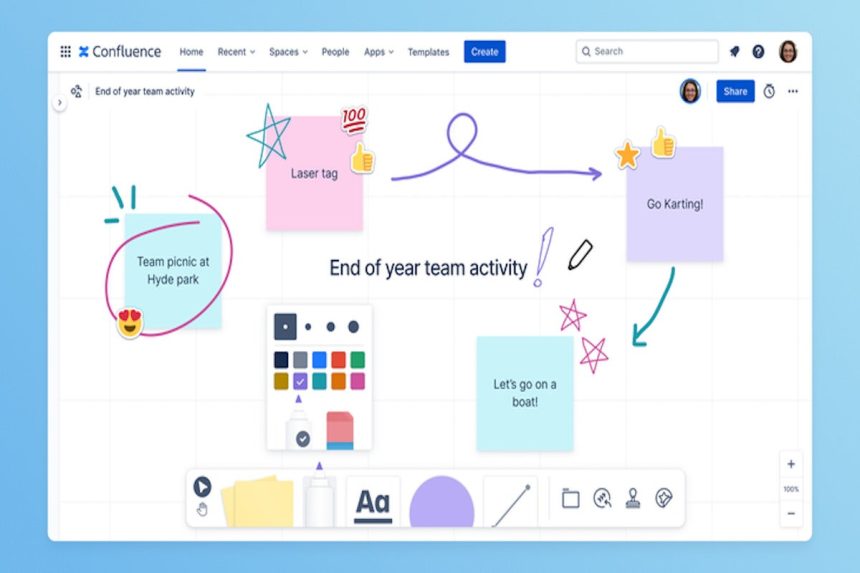Atlassian unveiled a host of new features for its Confluence workplace management platform Wednesday, offering new ways of working with additional types of content.
The key announcement is the addition of native whiteboards to Confluence, alongside new databases resulting from the company’s recent acquisition of Orderly Databases from solution partner K15t. Confluence is also allowing users to broaden their ability to work with external partners, by providing guest spots and public links.
Atlassian’s partnership with portfolio company Hypothesis is also yielding results, with the launch of a new Chrome Extension app that enables Confluence users to comment and mention team members on web pages just as they would on Confluence pages.
“We fundamentally believe great achievements are impossible alone and our vision is to unlock the potential of every team,” said Erika Trautman, head of product for Atlassian’s Work Management offerings, adding that since the company’s inception, thinking about the creation and flow of information has always been at the forefront of product development.
Whiteboards for brainstorming
Built natively on the Atlassian platform, whiteboards in Confluence are designed to allow users to brainstorm freely using sticky notes, shapes, stamps, stickers, timers, and a pen, convert sticky notes into any Jira Cloud issues and Confluence pages, and visualize all your work by bringing Jira issues into one view with the option to add relationships labels.
Confluence will also be offering databases — structured tables that help teams connect and organize information such as Jira tasks, Confluence pages, due dates, and statuses in one database table.
Users can then reference an individual cell, row, or an entire table anywhere else in Confluence with real-time syncing. The idea is that your team is always connected with the most up-to-date information, automatically.
Both these new content types will live inside Confluence, in what Trautman describes as a recognition from Atlassian that work goes well beyond just the words that exist on a page.
Atlassian’s partnership with Hypothesis allows users to move away from commenting on manual screenshots by instead enabling them to comment directly on the relevant web page. Confluence will aggregate the comments for you so you can keep the conversation going, within the context of the webpage, and without the manual screenshot process.
For example, teams can address feedback or typos on their website, discuss a new edit to their competitors’ pricing page, or share a statistic from a new article.
Collaborating with external partners, securely
Confluence is also providing users with the ability to securely collaborate with individuals outside of their organization, such as contractors, agencies, and other external collaborators. Every paid Confluence user will now be able to add up to five external guests, with no limit on the number of guests per space nor on the number of spaces allowed for guests.
Public links function as view-only versions of pages that get published on the web, meaning they won’t appear in search engine results. This allows users to share content more broadly on the internet like customer FAQs, release notes, shareholder letters with clients without needing to pay for an extra seat in Confluence.
Whiteboards will go into beta in July 2023 and will be generally available by the end of the year, while the databases beta will open by the end of the year and become generally available in the first half of 2024.
The Hypothesis Chrome app will be generally available by the end of the calendar year, while Guests and Public Links will be generally available in July and October 2023, respectively.
Opt-in for Atlassian Intelligence generative AI
In addition to all the new Confluence capabilities, users of the platform will also be able to opt into Atlassian’s new generative AI technology, Atlassian Intelligence, which aims to help support teams, accelerate work, provide instant help, and build a shared understanding of work among users.
In Confluence, users will be able to leverage Atlassian Intelligence to summarize meeting notes, create written drafts based off information stored on Confluence pages, provide instant definitions of company-specific jargon, and have it answer workplace-related questions.
“This as a really important evolution for Confluence as we’re in an era where the way that we work together and the foundation upon which we make decisions, share information and collaborate is evolving,” Trautman said, adding that both the concepts of how information is produced and who is producing it have now changed quite dramatically.
“We really believe in enabling people to work how they want to work, whether that is verbal, with images, or through the written word… and we are going to continue to invest in enabling all of those types of communication,” she said.




